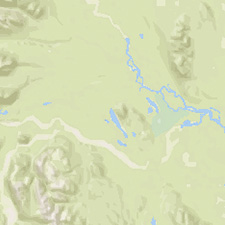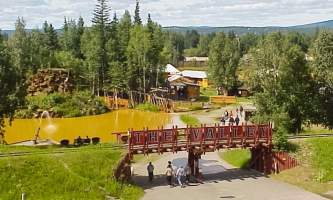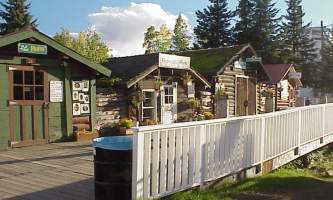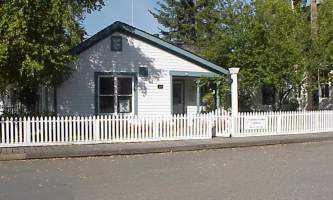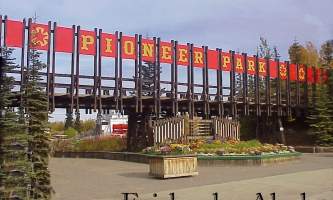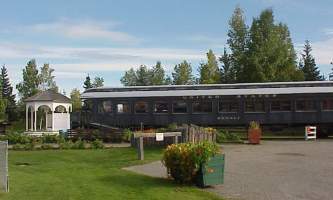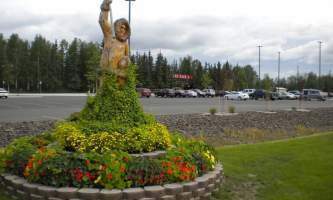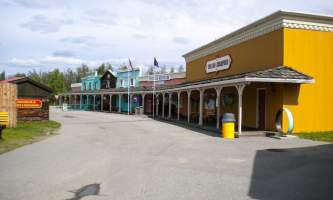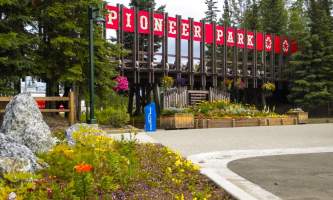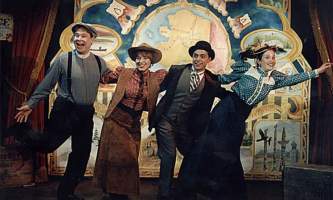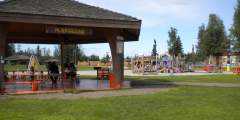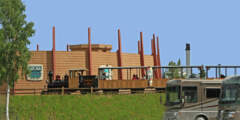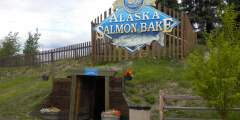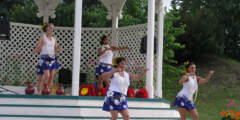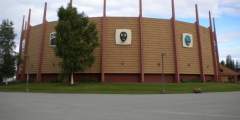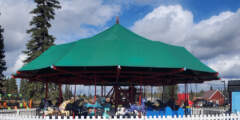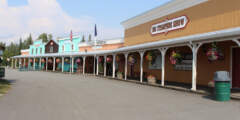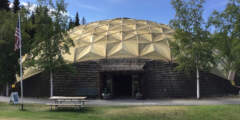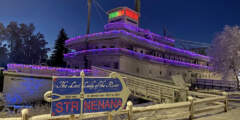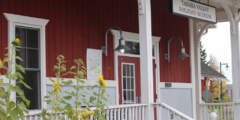Experience the interior of Alaska 100 years ago! Pioneer Park is a historic village that features original buildings moved from downtown Fairbanks, as well as museums, and the Gold Rush. Come enjoy the carousel and train that runs the perimeter of the park, an array of local shops, and rustic cabin restaurants. Stay for a couple of hours or spend a full day; Pioneer Park offers fun for the whole family. To see upcoming events or to book a reservation within the park, please visit their website.
What It’s Like
In Summer
From Memorial Day until Labor Day, enjoy the museums, take a spin on the carousel, explore the historic Gold Rush Town, and hop on the train that chugs around the park. Art lovers can peruse the fine sculptures and paintings in Bear Gallery, which is in the Centennial Center. Shoppers can browse the stores located in the agrestic cabins and grab a bite to eat at one of the restaurants which range from American to Mediterranean. Enjoy your meal at one of the picnic tables along the river, next to the playgrounds or throughout the park. Afterwards, drop by The Mining Valley, where old pieces of equipment and interpretive signs give you a great feel for what local mining was like. Grab duck feed from the Pick-n-Poke and feed the ducks that nest in the pond nearby. Be sure to stay for the nightly Salmon Bake and dinner show about the colorful characters who came here in search of gold.
Feeling active? Play the 3-hole disc golf course, mini golf, bocce ball, corn hole, and horseshoes. Or rent a canoe, kayak, or bike with Canoe Alaska and cruise the Chena River.
In Winter
Pioneer Park is open all winter! While the shops and restaurants close for the season, you can still walk around and get a feel for Alaska’s early years while walking the Gold Rush Town and reading the placards about the cabin’s origin stories. It’s also a good place to get into the holiday spirit; there’s a tree-lighting ceremony on the Saturday after Thanksgiving each year, and the holiday lights stay up through March. And don’t miss a stop at the Bear Gallery (winter hours: 12 p.m.–6 p.m. Tuesday–Saturday) to check out the fine art on display.
The History
Pioneer Park opened in 1967 as part of the Alaska ‘67 Centennial Exposition, celebrating the 100th anniversary of Alaska’s purchase from Russia. The park featured a zoo and rides in those early days, when it was known as Alaska 67 and then Alaskaland. The name was changed to Pioneer Park in 2001, to reflect its focus on history.
The surrounding area also has a fascinating past. Along the park’s northern border lies the Chena River, a name of Athabascan origin derived from “che” (meaning “stick”) and “na” (meaning “river”)—the Stick River. It was this river that Fairbanks’ founding father, E.T. Barnette, traveled up in 1901. He was searching for the town of Tanana Crossing (now called Tanacross), where he hoped to establish a trading post. But his boat, the Lavelle Young, hit a sandbar, and he was forced to spend the winter along the banks of the Chena River. The following spring, miner Felix Pedro found gold in the surrounding hills, and Barnette decided to stay and establish his trading post there. That early community was known as Barnette’s Cache. Within a year, however, it became known as Fairbanks, named after Indiana Senator Charles Fairbanks (who went on to serve as Theodore Roosevelt’s Vice President during Roosevelt’s second term).
Getting There
Fairbanks, AK 99701
By Car: Entering town via the Parks Highway, heading east, exit onto Airport Way, turn left onto Peger Road, then take a right on the Airport Way Frontage Road, and enter into the Pioneer Park parking lot on the left.
Prices & Dates
| Season | Memorial Day - Labor Day |
Show Map
Points of Pioneer Park
A Fairbanks family favorite, the playground is located at the center of the park and is designed for several age groups with an animal train, swings, spiral slide, net climber, and additional play areas.
RV parking in the Heart of Fairbanks open Memorial Day to Labor Day. Rates are $12 a night, on a first come first served basis.
Looking for a relaxed dinner after a busy day of adventures? Head to the Alaska Salmon Bake — the only one in Fairbanks — where you’ll enjoy an array of fine dining, surrounded by a historic park filled with rustic buildings and mining equipment. Take your pick of fire grilled Alaskan salmon, beer battered cod, or prime rib, cooked to perfection.
These music performances are sponsored by the Fairbanks Arts Association. They are held at the gazebo throughout the summer. Bring a chair or blanket to sit on as bench seating is limited.
The Alaska Centennial Center for the Arts was built in 1967 and designed to resemble a southeast Alaska tribal hall. The masks on the outside represent animal spirits. Many people think the building looks more like a birthday cake, which is fitting since it was built for Alaska’s 100th birthday. Some Fairbanksans also refer to the center as the Pickle Barrel. The Alaska Centennial Center for the Arts is rumored to be haunted.
On the north side of the park along the edge of the Chena River, Canoe Alaska provides one of Fairbanks’ few, outdoor family adventure activities. Canoe Alaska rents kayaks, canoes, and bicycles for half-days, a day, or by the week.
Lovingly owned and operated by Roela Olsen since 2006, this carousel is fun for the whole family and Roela also offers treats and drinks next to the carousel during the open season! According to the National Carousel Association this merry-go-round was built in the 1930’s. The carousel traveled via the Alaskan Highway to make its debut in the Golden Heart Plaza for the Silver Anniversary of the Fairbanks North Star Borough.
Pioneer Hall was designed in 1966 to represent a fine 1900’s era building. It houses the Pioneer Museum and The Big Stampede Theater.
The mission of the Pioneer Air Museum is to collect, protect, and preserve for educational purposes objects that reflect the history of interior and arctic Alaskan aviation through acquiring, restoring, interpreting, and displaying historically significant objects. View logbooks, clothing, maps, early flight instruments, and aircraft sporting skis and floats adapted to rugged Alaskan runways.
The Riverboat SS Nenana is a sternwheeler, nicknamed the “Queen of the Yukon.” She was commissioned by the Alaska Railroad and built in 1933. The boat is currently undergoing restoration. The sternwheeler is the second largest wooden hull vessel in the world, and was named a National Historical Landmark in 1989.
Visitors can purchase tickets to hop aboard the Crooked Creek Whiskey Island Railroad encircling Pioneer Park and pulled by Old 67. It’s just $3 for adults and $2 for seniors and kids under 12 (lap babies are free). The train runs every 15 minutes during the open season from noon to 7:30pm. An on-board guide points out historic attractions and activities in each section.

